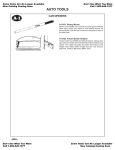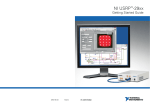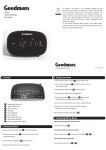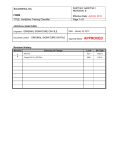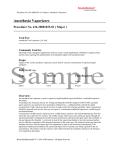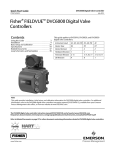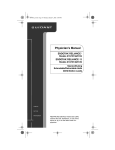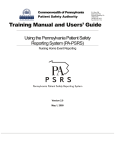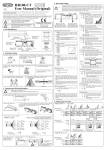Download Print / Save PDF - Pennsylvania Patient Safety Authority
Transcript
Patient Safety Advisory Produced by ECRI Institute & ISMP under contract to the Patient Safety Authority Baxter Colleague Volumetric Infusion Pump: Product Recall Notifications Bioengineering Corner P A-PSRS has received reports describing stopped infusions of the Baxter Colleague series infusion pumps. Most reports did not indicate the cause of the stopped infusion. However, one report described a pump that was hot to the touch and that leaked clear fluid from the pump; two reports described pump failures during patient transport, specifically due to low or “dead” batteries; and two reports described pumps not infusing, possibly due to low battery conditions (for additional information, see the PA-PSRS reports below). There were no reported patient injuries. While the causes of the unanticipated stopped infusions may be due to random malfunctions of the pumps or batteries that were not fully charged, Baxter has issued product recall notifications based on similar battery-related circumstances. The fact that PA-PSRS has received reports of previously documented problems related to the Colleague series pumps suggests that steps intended to address these problems may not have reached all clinical settings or facilities. Healthcare facilities experiencing repeated battery-related problems with the Colleague series infusion pumps may not associate the events with a potential systemic battery problem as outlined in the product recall notifications described below. Additionally, understanding proper battery management will help reduce some infusion pump failures. This article focuses on the product recall notifications related to events reported to PA-PSRS; however, a number of product recalls have been issued for the Colleague pumps for other reasons, some of which led to the U.S. Food and Drug Administration (FDA) seizure of some Colleague infusion pumps. For more information, see the sidebar “Baxter Colleague Volumetric Infusion Pump Recall: Background behind FDA’s Seizure.” Five PA-PSRS Report Event Descriptions The pump alarmed failure and stopped. The roller clamp was closed on the tubing, (MSO4 infusing), by nurse. The pump was hot to the touch, odor was present, and clear fluid was leaking from the machine. Once ©2007 Pennsylvania Patient Safety Authority the pump was disconnected and removed, the odor went away. The IV tubing was examined for any leakage, but none was found. The patient was aroused easily. The patient was alert and oriented. Vitals were 110-120 systolic, PO was 98%, and no respiratory distress was noted. The pump was removed from service and sent to biomedical. A new pump was applied. After unplugging the IV pump for patient transport, the pump failed. The battery for back up was dead. The patient was to return from CT scan, the pump alarmed “Battery” upon disconnection from the wall outlet. The pump was plugged into the wall outlet while waiting for the elevator. The pump again alarmed “Battery” after getting off elevator. The patient was rushed to the room, and the pump was plugged in but it was not delivering medication. The patient was returned to baseline assessment with increased BP as medication was transferred to another IV pump. Triple IV pump failure reading low battery upon being plugged in all day. The pump failure occurred while in use for patient care. [Shut off] would not turn back on. Staff found IV integrilin not infusing on Baxter pump. The pump was not on or plugged in. The Baxter pump was low when turned on and plugged in. Baxter Colleague Recall Notifications The report describing fluid leaking from the pump may be related to a Baxter recall notification of This article is reprinted from the PA-PSRS Patient Safety Advisory, Vol. 4, No. 1—March 2007. The Advisory is a publication of the Pennsylvania Patient Safety Authority, produced by ECRI Institute & ISMP under contract to the Authority as part of the Pennsylvania Patient Safety Reporting System (PA-PSRS). Copyright 2007 by the Patient Safety Authority. This publication may be reprinted and distributed without restriction, provided it is printed or distributed in its entirety and without alteration. Individual articles may be reprinted in their entirety and without alteration provided the source is clearly attributed. To see other articles or issues of the Advisory, visit our Web site at www.psa.state.pa.us. Click on “Advisories” in the left-hand menu bar. Page 1 Reprinted from the PA-PSRS Patient Safety Advisory—Vol. 4, No. 1 (March 2007) Baxter Colleague Volumetric Infusion Pump: Product Recall Notifications (Continued) standard procedure during infusions. Pressing the panel-lockout button on the rear of the pump will enable this feature. When the panel lockout feature is enabled, all inputs from the on/off key are ignored, and the malfunction described above should not occur. If it does occur, an alarm will activate to notify the user. Alternatively, enabling the autolock feature in the configuration settings of the pump results in automatic setting of the panel-lockout two minutes after the start of an infusion. long-term exposure to fluid. Fluid that enters Colleague monochrome-display infusion pumps either during cleaning or after spilling a significant amount of IV solution could contact the ribbon cable behind the keypad, degrading the cable and causing a malfunction of the power “on/off” circuitry.1 On January 11, 2002, Baxter issued a recall by an Urgent Device Correction letter to Colleague users regarding unexpected “power on” or “power off” without a key press if fluid enters the main body of the pump after long-term exposure. To remedy the problem, Baxter made available an insulator to be placed in the area of the ribbon cable to prevent fluid from contacting the cable. In the interim, Baxter provided the following information to users to prevent the malfunction from occurring: • • Do not spray cleaning fluid onto the body of the pump or submerge the pump for cleaning. Following the recommended cleaning instructions, cleaning fluid should not enter the pump. Use the panel-lockout feature as recommended in the Colleague user manual as a • If a pump becomes exposed to excessive fluid, remove it from use and contact Baxter to schedule service. • Remove from service any Colleague pumps that are reported to show this on/off problem or similar behavior. • Install the protective insulator at the location of the ribbon cable. The insulator and instructions are provided at no charge to users. To obtain the insulator and instructions, contact your local Baxter representative. NOTE: Because the correction letter was issued in Baxter Colleague Volumetric Infusion Pump Recalls: Background behind FDA’s Seizure Baxter has marketed the Colleague series volumetric infusion pumps since the late 1990s. Since 1999, the Colleague series pumps have encountered various problems requiring modifications. Early reported problems included software errors, pump motor failures, premature battery failures, failures of one channel in the triple channel Colleague pumps that would cause all three channels to stop operating, and random failure codes.1 During the past few years, the Colleague series infusion pumps have been involved in a number of product recalls for various problems causing pumps to stop infusing. Due to continuing problems with the Colleague series pumps, in late 2005, the U.S. Food and Drug Administration (FDA) seized approximately 6,000 Baxter-owned Colleague infusion pumps.2 The seizure did not affect customer-owned Colleague pumps. On October 13, 2005, Baxter issued a press release regarding FDA’s seizure of Colleague infusion pumps. FDA stated that the Colleague pumps have a design defect that may cause pumps to stop infusing, that the seized pumps were not manufactured under proper controls, and that Baxter failed to inform FDA of Colleague infusion pump failures. FDA believes that interruption in infusion therapy could result in serious injuries or death to critically ill patients dependent on continuous and/or life-sustaining medications.2 Page 2 In a field correction letter dated July 20, 2005, Baxter identified a problem with the pump’s clocking circuit as a source of the stopped infusions, which contributed to the FDA seizure. The clocking circuit can generate random failure codes, which could disrupt internal communications. Failure codes that could appear are 402, 403, 532, 533, 534, 535, 599, 702, 703, 704, 804:21, 804:22, 804:29, 804:34, 04:52, 804:58, and 12:303:xxx:0006. If any of these codes appear, the pump will alarm and stop infusing.3 Perspectives on the Colleague Recalls and Seizure The effects of the above Colleague pump failures result in stopped infusion and alarm notification, which would alert clinicians to initiate an appropriate response. The result would be no different than a pump stopping an infusion and alarming because it detected a true air-in-line or occlusion condition; when a pump stops in such a manner, it is considered to be failing in a “safe” manner. Additionally, the failure codes listed above are not exclusive to the clocking circuit failure. A pump exhibiting one of the related codes does not necessarily mean a clocking circuit failure occurred. Therefore, pumps with clocking circuit (Continued on page 3) ©2007 Pennsylvania Patient Safety Authority Reprinted from the PA-PSRS Patient Safety Advisory—Vol. 4, No. 1 (March 2007) Baxter Colleague Volumetric Infusion Pump: Product Recall Notifications (Continued) 2002, any affected pumps may already have the insulator installed. Contact your facility’s Biomedical or Clinical Engineering departments or Baxter to determine if the insulator is installed in your pumps. second battery was added to the pump’s design—to allow the pumps to interface with the two-battery configuration. (Note: Since the product information letter was issued in 2003, your facility’s pumps may already have been upgraded to software version 4.02 or greater. Checking with the facility’s biomedical or clinical engineering departments or the local Baxter representative will help to determine if the upgrade has been completed.) All of the aforementioned PA-PSRS reports may be related to battery issues described by Baxter in several of the following recall notifications: January 21, 2003. Baxter issued an Important Product Information letter to Colleague users describing pumps that could become hot to the touch because the pumps’ lead-acid batteries (i.e., two batteries per pump) swell as they near the end of their useful life. Batteries swelling could also cause internal pump damage.2 In the letter, Baxter also provided the following information: • The procedure for replacement, service life, and storage conditions of the sealed lead-acid batteries used in the pumps and indicated that for Colleague single-channel monochrome-display pumps with software below version 4.02, a software upgrade (version 4.02 or greater) was issued in September 2001—during a 2001 retrofit, a • Only the Yuasa NP2-12 (part no. UBAT1010.A) battery brand was approved by Baxter for use in the Colleague series pumps. Additionally, Baxter discovered that Ray-O-Vac batteries (Ray-O-Vac batteries were installed in Colleague pumps prior to September 2001) used in the pumps were more susceptible to swelling and recommended that all Ray-O-Vac batteries be removed from the pumps and replaced. Baxter also recommended replacing both batteries at the same time with two new batteries. Swelling could be prevented by replacing both batteries before their end of useful life and by following good Baxter Colleague Volumetric Infusion Pump Recalls: Background behind FDA’s Seizure (Continued) failures would not be any more unsafe than other pumps. An exception to this is a case in which the battery is damaged due to excessive deep discharges and the pump is operating on battery power. In this case, the pump may not have enough battery power to operate for as long as expected; for example, a pump operates for only 5 minutes after the first low-battery alarm activates instead of the 30 to 60 minutes expected from a properly operating pump. In this situation, a clinician might miss the alarm condition if he or she believes that the pump shut down without alarming. In January 2006, Baxter issued a letter to Colleague users regarding ongoing corrective actions to address the clocking circuit problem. In May 2006, Baxter submitted an amended 510(k) package to FDA for a permanent hardware solution for the clocking circuit problem. In a June 2006 letter, Baxter announced a consent decree agreement with FDA on the sale of Colleague pumps in the United States (i.e., Baxterowned pumps in the distribution system, not pumps in clinical use). Baxter agreed to stop manufacture and distribution of Colleague pumps in the United States until the firm can ensure that the devices comply with Good Manufacturing Practices (GMP) requirements. The agreement allows Baxter to continue to perform routine maintenance and to ©2007 Pennsylvania Patient Safety Authority replace components, parts, and accessories for the pumps that were distributed to customers before October 12, 2005.4 Subsequent to the consent decree, Baxter retracted the amended 510(k) submission. In December 2006, Baxter announced that FDA issued conditional approval for the Colleague pump corrective action plan and that an updated 510(k) filing was submitted to FDA. On February 27, 2007, FDA and Baxter announced that Baxter received 510(k) clearance for the modified Colleague infusion pumps that addresses the problems that resulted in FDA seizure of the pumps.5 Notes 1. ECRI Institute. Baxter Colleague family of pumps has required numerous modifications [evaluation]. Health Devices 2002 Oct;31(10):377. 2. ECRI Institute. FDA seizes Baxter Colleague and Syndeo infusion pumps. Health Devices Alerts 2005 Oct 28. Special Report Accession No. S0098. 3. ECRI Institute. Baxter—Colleague infusion pumps: pump may cease operation. Health Devices Alerts 2005 Aug 5. Action Item Accession No. A6520. 4. ECRI Institute. Baxter—Colleague and Syndeo infusion pumps: following device seizures by FDA, Baxter signs consent decree. Health Devices Alerts 2006 Aug 11. [update] Action Item Accession No. A7510. 5. Baxter Healthcare. Baxter receives 510(k) clearance from FDA for Colleague infusion pumps [press release online]. 2007 Feb 27 [cited 2007 Mar 15]. Available from Internet: http://www.baxter.com/about_baxter/ news_room/news_releases/2007/02-27-07-colleague.html. Page 3 Reprinted from the PA-PSRS Patient Safety Advisory—Vol. 4, No. 1 (March 2007) Baxter Colleague Volumetric Infusion Pump: Product Recall Notifications (Continued) battery-charging and pump-usage patterns. Baxter stated that a lead-acid battery has 68 or more full discharge/recharge cycles during its service life. The more often the battery is cycled, the sooner it needs to be replaced. Baxter also stated that normal ambient room conditions of 30°C/86°F or lower make for ideal storage conditions. Pumps that are plugged into AC power receptacles or batteries that are fully charged during storage in higher temperatures will reduce the likelihood of battery damage. Regardless of the ambient temperature, pumps should be plugged into AC power during storage to maintain the batteries at full charge. If any pumps are hot to the touch, remove the pumps from service and inspect the batteries as soon as possible. February 25, 2005. Baxter issued an Important Product Information letter with supplemental information to the January 21, 2003, letter. According to the supplemental letter, Colleague infusion pumps with serial numbers 13120001CS, 13110181CC, 13120001CT, 13110338TC and higher were manufactured with an overcurrent protection circuit in the battery harness to help protect the batteries from overcurrent damage and swelling during charging. For pumps with serial numbers below those listed above, Baxter made the new battery harness available to replace harnesses without the overcurrent protection.3 If applicable, checking with the facility’s biomedical or clinical engineering departments or the local Baxter representative will help determine if the new harness was installed. Baxter also offered the following information on excessive battery discharge: • • • Page 4 Damaging discharges may occur when the pump is left on battery power for an extended period after the “Battery Depleted” alarm occurs. When the batteries become damaged due to excessive discharge, the battery indicator will overstate the amount of charge remaining. While in “Battery Low” alert, a properly maintained battery will provide approximately 30 minutes of infusion time. Plugging the pump into an AC power receptacle when the “Battery Low” alert occurs will restore a battery’s charge. Damaged batteries do not impact the pump’s ability to function properly while operating on AC power, provided that no other failures or alarm conditions are present. • The battery and pump history service screen will identify the number of discharges below the alarm threshold. If more than one excessive discharge is listed in the battery history log, Baxter recommends testing or replacing both batteries. Battery test and installation instructions can be found in the Colleague pump service manual. December 13, 2005. In an Urgent Device Correction letter, Baxter identified a battery undercharging condition with the Colleague series pumps.4 Baxter stated that if the batteries are not charged continuously for 12 hours after a “Battery Low” alert or a “Battery Depleted” alarm occurs, the remaining operating time of the pump after a subsequent “Battery Low” alert may be less than 30 minutes. The subsequent “Battery Low” alert will be followed by both an audible and visual notification of a “Battery Depleted” alarm stopping the infusion therapy. According to Baxter, following the charging instructions listed in the Colleague pump user manual will help avoid interruption or stoppage of therapy, loss of configuration memory, and/or device failure. Maintenance Strategies Without additional information, we cannot be certain the reports to PA-PSRS described above are directly related to these product recall notifications, but the potential connection warrants concern. Healthcare facilities may find the following general strategies useful in properly maintaining Baxter Colleague infusion pumps: • Identifying whether the facility uses Baxter Colleague infusion pumps. • Searching the facility’s PA-PSRS reports to identify cases related to the Colleague pumps. • Screening those cases to identify reported problems similar to the ones outlined in this article. • If reported problems are similar to the ones outlined above, contacting the facility’s biomedical or clinical engineering departments or the local Baxter representative to determine if any related product recall notifications exist and have been addressed for suspect pumps. ©2007 Pennsylvania Patient Safety Authority Reprinted from the PA-PSRS Patient Safety Advisory—Vol. 4, No. 1 (March 2007) Baxter Colleague Volumetric Infusion Pump: Product Recall Notifications (Continued) • If recall notifications have not been addressed, coordinating with the facility’s biomedical or clinical engineering departments or Baxter to resolve the problem. • Following the battery management guidelines discussed in this article and in the Colleague pump user manual. Notes 2. ECRI Institute. Baxter—various colleague volumetric infusion pumps: supplemental information regarding sealed lead-acid batteries. Health Devices Alerts 2003 Feb14. Action Item Accession No. A4975. 3. ECRI Institute. Baxter—Colleague infusion pumps: harness available to prevent battery swelling and overheating. Health Devices Alerts 2005 Apr 8. [update] Action Item Accession No. A6188. 4. ECRI Institute. Baxter—Colleague infusion pumps: battery undercharging, false “air detected” alarms, gearbox wear, underinfusion, and nondetection of upstream occlusion. Health Devices Alerts 2006 Jan 20. Action Item Accession No. A6943. 1. ECRI Institute. 13215 infusion pumps, general-purpose. Health Devices Alerts 2002 Feb 15. Action Item Accession No. A4598. The PA-PSRS Patient Safety Advisory is issued quarterly, with periodic supplements. Previous issues are available on the Patient Safety Authority Web site at http://www.psa.state.pa.us. Click on “Advisories” in the left-hand menu bar. Selected articles in previous issues include: • Anesthesia Awareness (September 2005) • Bone Cement Implantation Syndrome (December 2006) • Delays in the OR: Stress between “Running Two Rooms” and “Time Outs” (September 2006) • Expecting the Unexpected: Ambulatory Surgical Facilities and Unanticipated Care (September 2005) • Forgotten But Not Gone: Tourniquets Left on Patients (June 2005) • I’m Stuck and I Can’t Get Out! Hospital Bed Entrapment (December 2006) • Improving Safety of Telephone or Verbal Orders (June 2006) • Risk of Fire from Alcohol-Based Solutions (June 2005) • Skin Tears: The Clinical Challenge (September 2006) • Who Administers Propofol in Your Organization? (March 2006) ©2007 Pennsylvania Patient Safety Authority Page 5 Reprinted from the PA-PSRS Patient Safety Advisory—Vol. 4, No. 1 (March 2007) An Independent Agency of the Commonwealth of Pennsylvania The Patient Safety Authority is an independent state agency created by Act 13 of 2002, the Medical Care Availability and Reduction of Error (“Mcare”) Act. Consistent with Act 13, ECRI Institute, as contractor for the PA-PSRS program, is issuing this newsletter to advise medical facilities of immediate changes that can be instituted to reduce Serious Events and Incidents. For more information about the PA-PSRS program or the Patient Safety Authority, see the Authority’s Web site at www.psa.state.pa.us. ECRI Institute, a nonprofit organization, dedicates itself to bringing the discipline of applied scientific research in healthcare to uncover the best approaches to improving patient care. As pioneers in this science for nearly 40 years, ECRI Institute marries experience and independence with the objectivity of evidence-based research. More than 5,000 healthcare organizations worldwide rely on ECRI Institute’s expertise in patient safety improvement, risk and quality management, and healthcare processes, devices, procedures and drug technology. The Institute for Safe Medication Practices (ISMP) is an independent, nonprofit organization dedicated solely to medication error prevention and safe medication use. ISMP provides recommendations for the safe use of medications to the healthcare community including healthcare professionals, government agencies, accrediting organizations, and consumers. ISMP's efforts are built on a non-punitive approach and systems-based solutions. Page 6 ©2007 Pennsylvania Patient Safety Authority






